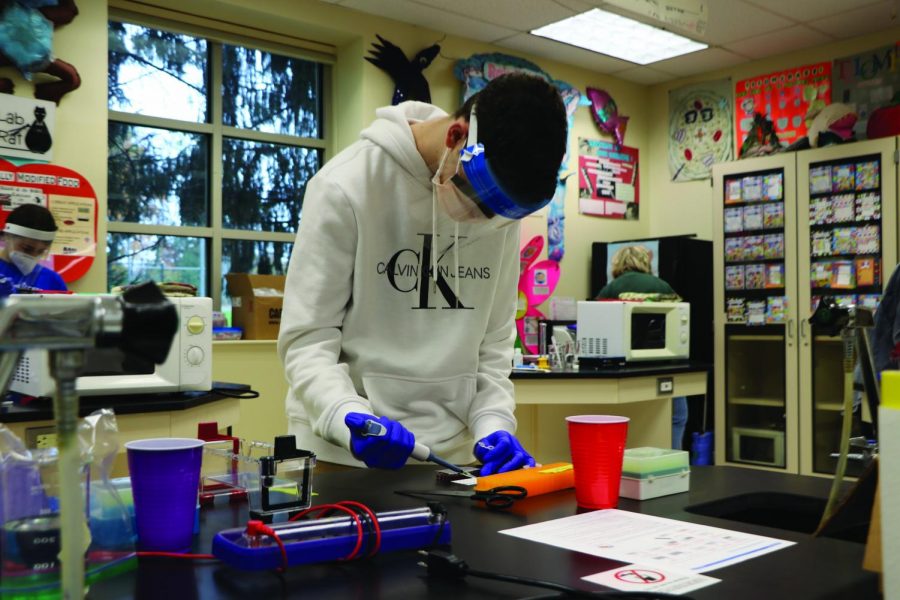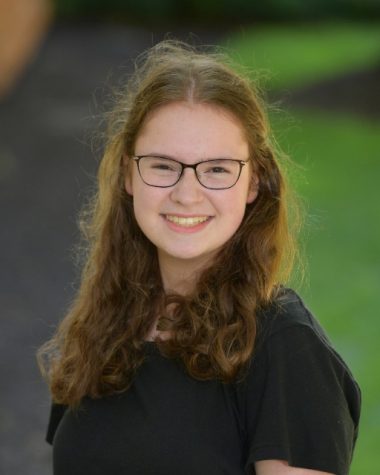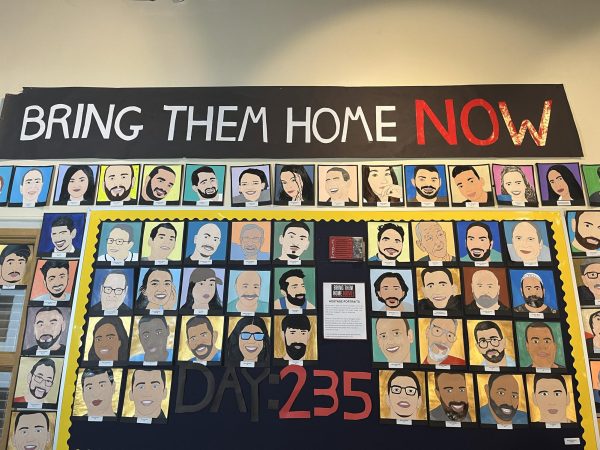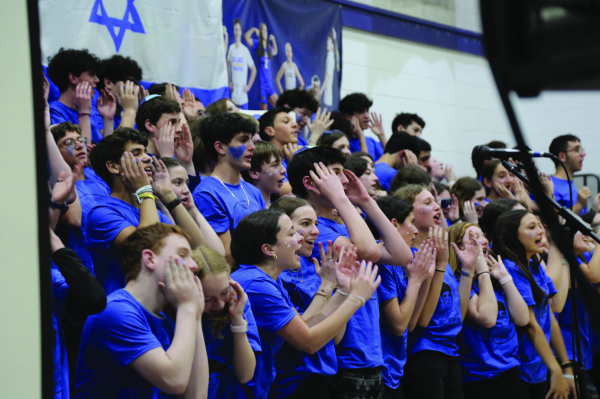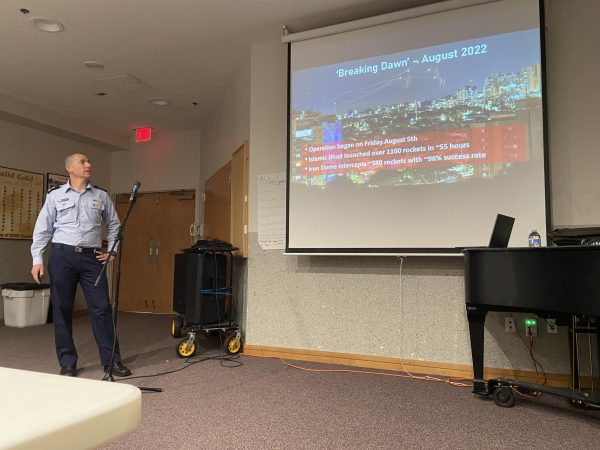Returning to campus: As hybrid learning begins, students and faculty adjust to new circumstances
High school students engage in indoor science labs as the school begins to transition to hybrid learning.
November 6, 2020
High school students will soon begin transitioning into hybrid learning environments, Head of School Rabbi Mitchel Malkus announced on Oct. 30.
The CESJDS Health Advisory Committee, comprised of one NIH Researcher and two doctors with their own practices who are in the JDS community, has been working with the JDS school board and administration to ensure that proper safety procedures are being taken in the return to school.
The high school is expected to move into hybrid learning beginning Dec. 1. Malkus said there are two statistics that JDS and its Health Advisory Committee will monitor as decisions continue to be made regarding hybrid learning: Montgomery County’s test positivity rate and number of cases per 100,000 people.
That threshold is below 5% for test positivity and 15 or fewer cases per 100,000, an increase from a threshold set earlier in the year of 10 or fewer cases per 100,000. This change was made in the community update sent out on Oct. 30. Since no one in the JDS community has tested positive since the administered testing began in October, it was deemed acceptable to amend the maximum per 100,000 to 15 cases.
Over the past two months, test positivity has remained stable in Montgomery County, while the cases per 100,000 have risen from about seven to nearly 14, according to the Montgomery County Government’s COVID-19 data.
Upper School Nurse Heather Greenblum explained that health screening using the Magnus app, fever checks, temperature checks and COVID-19 testing will now be required. The flu vaccine has been added to the list of requirements as well, since its symptoms are similar to the coronavirus.
“Until you get a test, we have to assume it’s COVID,” Greenblum said.
As more students come on campus, testing will be required for the student body and faculty, which will amount to approximately 500 tests per week. As of Oct. 30, over 836 COVID-19 tests had been distributed and administered, and so far there have been no positive results.
COVID-19 tests will be available at both the Lower and Upper School campuses. Students have been assigned to testing sessions based on groups such as their age, cohort, clubs or athletics.
In the event that a student tests positive, JDS must immediately report the case to the Montgomery County Health Department. The student will not be able to return to campus until they test negative and quarantine for at least 10 days.
Additionally, Greenblum will assume the responsibility of contact tracing, the act of instructing those who may have been in contact with a person who tested positive to abide by Montgomery County guidelines to quarantine.
While the desire to return to school is heavily based on the value of in-person learning, the reality is that not every faculty member is in a position to return.
“We expect all of the faculty to come on campus; however, there are some faculty that are in high risk [categories] or live with someone who is,” Malkus said. These faculty are allowed to continue teaching from home, even when their students are in the classroom together.
Jewish Text and English teacher Grace McMillan, along with approximately 20% of the faculty, has opted to teach from home due to health concerns for herself and for her husband.
“I feel really guilty,” McMillan said, “… because I know that some of my colleagues are going to be proctoring my classes .… I think my not being able to come in puts an extra burden on them, and I’m very grateful to them.”
McMillan noted that the administration has been exceedingly understanding regarding the extreme risk she would face in a building with students during the pandemic.
“The school has been quite ready to recognize that for the particular health concerns that my family has, there is no question,” McMillan said.
While many students are eager to return to a more normal way of learning among their peers, there continue to be health and safety concerns among students as well.
Junior Noam Zaremba supports the move to hybrid learning.
“When I’m in class I like to be engaged, I think there are certain aspects of a classroom setting that just enhance the experience,” Zaremba said.
Not only does Zaremba value being in a physical classroom, but he has found distance learning to be particularly challenging.
“Online school has kind of been like a bumpy roller coaster for me. It’s very overwhelming; I would be remiss not to mention that,” Zaremba said.
Junior Zoe Wertlieb has also been struggling with the constraints of distance learning.
“Online school hasn’t been going super well for me, [and] my grades are definitely worse,” Wertlieb said. “But to me, it’s so much more worth it to be safe and have my grades suffer a tiny bit.”
Even with the precaution of weekly testing for students in hybrid learning, every family takes different safety measures.
“I know that a lot of people aren’t social distancing and aren’t really wearing masks anymore,” Wertlieb said. “I’m worried that being in school with them puts myself and also my parents and their parents at risk.”
Additionally, scientists suggest that cases will increase during the winter because the coronavirus spreads more easily in indoor settings, where people will be spending more time as the temperature drops. Even with the local statistics being watched by the JDS Health Advisory Committee, Americans have been warned of a surge of cases throughout the upcoming winter months.
“If we were to have gone back, we missed our window,” Wertlieb said.
Initially, the school decided to begin the year strictly with distanced learning due to the high percentage of people testing positive for COVID-19 in Montgomery County. However, the number of cases and risk within the JDS community turned out to be drastically different from those of the County.
The week of Oct. 26 was the first week of hybrid learning for the Lower and middle school students, with Lower School grades going in twice a week and middle school once a week.
Sixth-grader Lilah Sacks attended her first day of hybrid learning on that day along with the rest of her grade.
“I was excited, also a little nervous … but I thought it was fun,” Sacks said.
Since this was the first time that sixth grade students had attended JDS in the Upper School building, it was also the first time they interacted with their teachers in person.
“I guess yesterday [Oct. 26] was also pretty cool because I got to see all my teachers in person and found out that they had legs,” Sacks said.
Similarly, returning middle school teachers were eager to finally be with their students in-person.
“I was really excited to see my students who I hadn’t gotten to see in-person yet,” Humanities teacher Tamar Gasko said. “It’s easier to do my job and to relate to students when I’m doing it in person.”
However, Gasko also noted that she was “a little nervous and apprehensive” about teaching in person with some students still connecting through Zoom.
Although it was exciting to be back in the building and in classrooms, Middle School Principal Eliana Lipsky also understood the challenges that the teachers would have to overcome, specifically regarding students who remained on Zoom despite their peers’ return to the classroom.
“But it’s worth it. The challenge is worth it, because kids learning together and being together is really important,” Lipsky said.
Among the challenges of having students both in and outside of the classroom, there was a newfound challenge of holding a class that was supposed to be “normal” in an abnormal, unfamiliar space. Some classes were held outdoors to maximize safety. Sacks described the classrooms as having, “two chairs per table and … plexiglass partitions. It’s kind of like a cage, but they’re trying to make it safer.”


